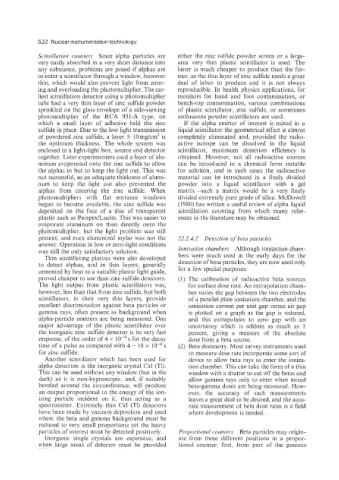Page 550 - Instrumentation Reference Book 3E
P. 550
532 Nuclear instrumentation technology
Scintillation counters Since alpha particles are either the zinc sulfide powder screen or a large-
very easily absorbed in a very short distance into area very thin plastic scintillator is used. The
any substance, problems are posed if alphas are latter is much cheaper to produce than the for-
to enter a scintillator through a window, however mer, as the thin layer of zinc sulfide needs a great
thin, which would also prevent light from enter- deal of labor to produce and it is not always
ing and overloading the photomultiplier. The ear- reproducible. In health physics applications, for
liest scintillation detector using a photomultiplier monitors for hand and foot contamination, or
tube had a very thin layer of zinc sulfide powder bench-top contamination, various combinations
sprinkled on the glass envelope of a side-viewing of plastic scintillator, zinc sulfide, or sometimes
photomultiplier of the RCA 931-A type, on anthracene powder scintillators are used.
which a small layer of adhesive held the zinc If the alpha emitter of interest is mixed in a
sulfide in place. Due to the low light transmission liquid scintillator the geometrical effect is almost
of powdered zinc sulfide, a layer 5-10mg/cm2 is completely eliminated and, provided the radio-
the optimum thickness. The whole system was active isotope can be dissolved in the liquid
enclosed in a light-tight box, source and detector scintillator, maximum detection efficiency is
together. Later experimenters used a layer of alu- obtained. However, not all radioactive sources
minum evaporated onto the zinc sulfide to allow can be introduced in a chemical form suitable
the alphas in but to keep the light out. This was for solution, and in such cases the radioactive
not successful, as an adequate thickness of alumi- material can be introduced in a finely divided
num to keep the light out also prevented the powder into a liquid scintillator with a gel
alphas from entering the zinc sulfide. When matrix-such a matrix would be a very finely
photomultipliers with flat entrance windows divided extremely pure grade of silica. McDowell
began to become available, the zinc sulfide was (1980) has written a useful review of alpha liquid
deposited on the face of a disc of transparent scintillation counting from which many refer-
plastic such as PerspexILucite. This was easier to ences in the literature may be obtained.
evaporate aluminum on than directly onto the
photomultiplier, but the light problem was still
present, and even aluminized mylar was not the 22.2.4.2 Detection of beta particles
answer. Operation in low or zero-light conditions
was still the only satisfactory solution. Ionization chainbers Although ionization cham-
Thin scintillating plastics were also developed bers were much used in the early days for the
to detect alphas, and in thin layers, generally detection of beta particles, they are now used only
cemented by heat to a suitable plastic light guide, for a few special purposes:
proved cheaper to use than zinc sulfide detectors. (1) The calibration of radioactive beta sources
The light output from plastic scintillators was, for surface dose rate. An extrapolation cham-
however, less than that from zinc sulfide, but both ber varies the gap between the two electrodes
scintillators, in their very thin layers, provide of a parallel plate ionization chamber. and the
excellent discrimination against beta particles or ionization current per unit gap versus air gap
gamma rays, often present as background when is plotted on a graph as the gap is reduced,
alpha-particle emitters are being measured. One and this extrapolates to zero gap with an
major advantage of the plastic scintillator over uncertainty which is seldom as much as 1
the inorganic zinc sulfide detector is its very fast percent, giving a measure of the absolute
response, of the order of 4 x s for the decay dose from a beta source.
time of a pulse as compared with 4 - 10 x s (2) Beta dosimetry. Most survey instruments used
for zinc sulfide. to measure dose rate incorporate some sort of
Another scintillator which has been used for device to allow beta rays to enter the ioniza-
alpha detection is the inorganic crystal CsI (TI). tion chamber. This can take the form of a thin
This can be used without any window (but in the window with a shutter to cut off the betas and
dark) as it is non-hygroscopic, and, if suitably allow gamma rays only to enter when mixed
beveled around the circumference, will produce beta-gamma doses are being measured. How-
an output proportional to the energy of the ion- ever, the accuracy of such measurements
izing particle incident on it, thus acting as a leaves a great deal to be desired, and the accu-
spectrometer. Extremely thin CsI (Tl) detectors rate measurement of beta dose rates is a field
have been made by vacuum deposition and used where development is needed.
where the beta and gamma background must be
reduced to very small proportions yet the heavy
particles of interest must be detected positively. Proportional counters Beta particles may origin-
Inorganic single crystals are expensive, and ate froin three different positions in a propor-
when large areas of detector must be provided tional counter; first, from part of the gaseous

